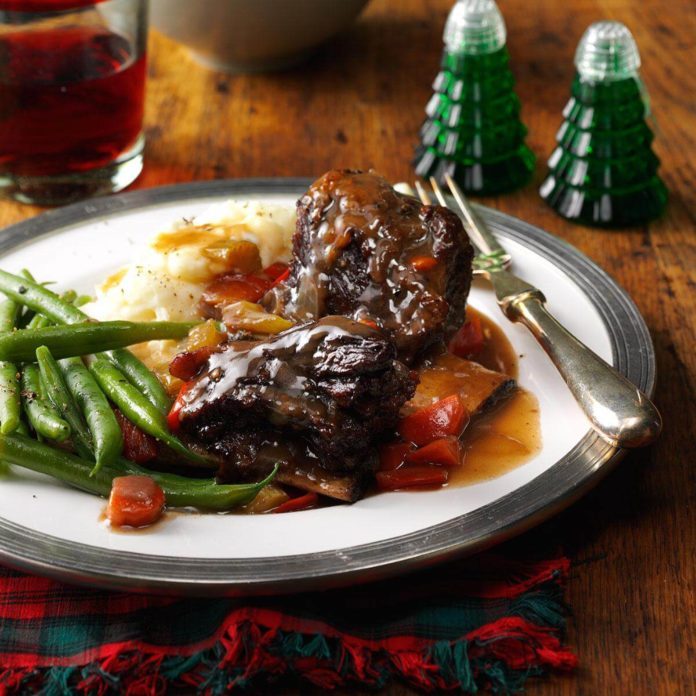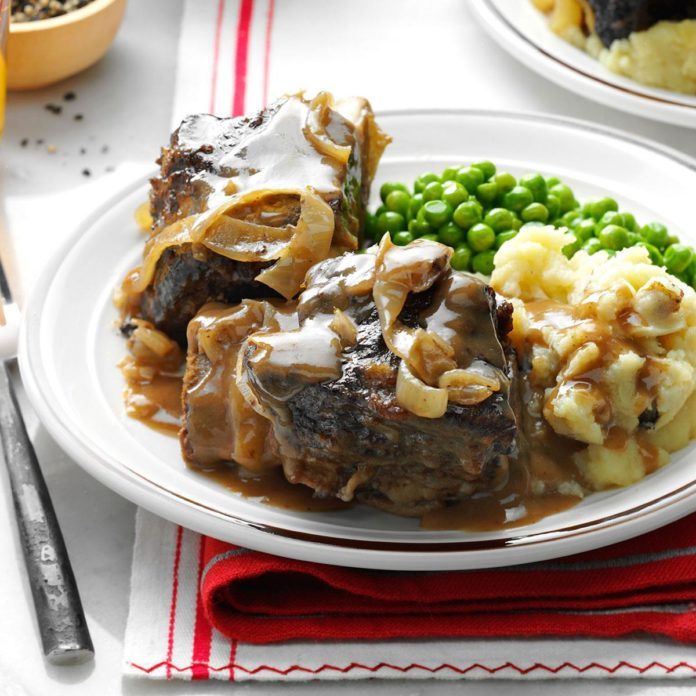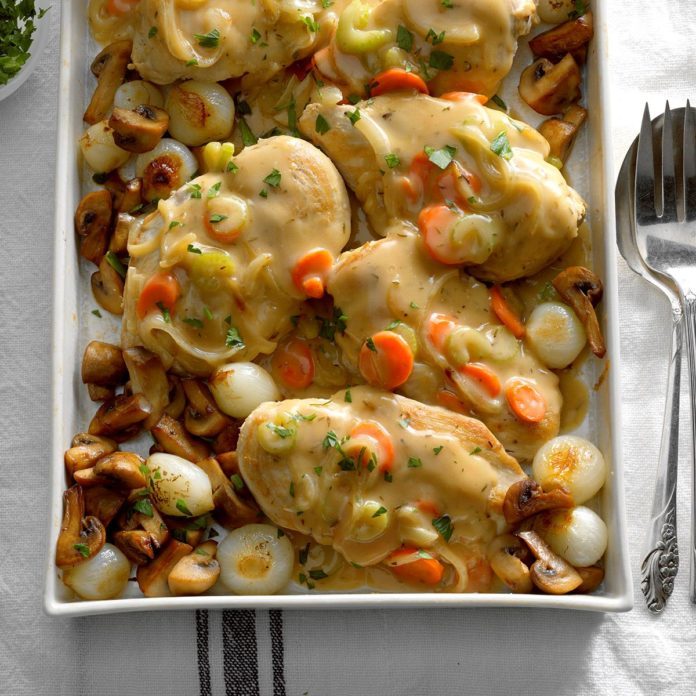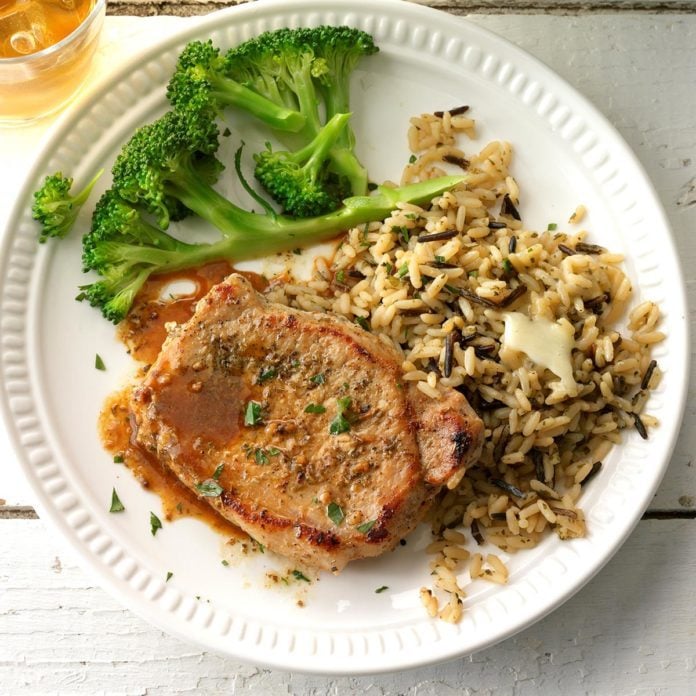If you’re looking for a comforting, rich, filling meal that requires very little intervention, braising meat is the way to go. You basically throw everything into a Dutch oven and the meal prepares itself!
Bonus: this cooking technique magically transforms tough cuts of meat into tender bites, making it an inexpensive way to feed a crowd. Meats like chuck roast, lamb shanks and short ribs wouldn’t taste great cooked over the high heat of the grill, but they become juicy and tender after being braised.
What does braising mean?
Braising is a combination cooking method that uses both dry- and moist-heat techniques to break down tough cuts of meat over a long period of time. You start by searing the food in a small amount of oil to caramelize the outside, browning and crisping up the exterior without cooking the meat all the way through. Then, you add liquid—it can be broth, wine, beer, cider or even water—and simmer the meat over gentle heat for hours until it becomes soft and tender.
What’s the difference between braised meat and stewing recipes like beef stew? Braising uses just enough liquid to come halfway to three-quarters of the way up the meat. Stewing, on the other hand, submerges the food in liquid (like a soup). Stews also generally call for the meat to be cut into small, uniform-sized pieces, whereas braised meat can be left whole in its original roast form.
How to Braise Meat Without a Recipe
The best meats for braising are large cuts with lots of connective tissue. When exposed to low temperatures for a long period of time, that tissue breaks down and turns into gelatin, infusing the meat with rich flavor and giving body to the cooking liquid. Look for pork shoulder or ribs for pork dishes, thighs or legs for chicken, and if lamb’s on the menu, you’ll want shanks, leg or a shoulder roast. There are a lot of options when it comes to beef. Chuck roast, short ribs and brisket are our favorites, but a rump roast or bottom round will work well, too.
Step 1: Sear the meat
Season the meat with salt and pepper and trim off any excess fat. Heat a small amount of neutral cooking oil (like canola oil) over high heat in a large Dutch oven. When the oil is shimmering, add the meat. It should sizzle as soon as it hits the pan; if it doesn’t, remove it and let the oil get hotter before proceeding.
Cook the meat for 1 to 2 minutes until it’s browned and caramelized. Flip it over and repeat the process on the other three sides. Remove the meat from the pan and set aside.
Step 2: Cook some aromatic ingredients
There will be some burnt-on bits at the bottom of the pan, but don’t fear: they’ll release over the next two steps and become a flavorful part of your sauce. Remove all but one tablespoon of the fat from the pan. Add a chopped onion, carrot and celery (and garlic, if you like). Cook, stirring from time to time, for about 5 minutes until they soften and the onions become lightly golden brown.
Before you move on to the next step, you can add dried or fresh herbs and cook them for an additional minute. Our favorites are thyme, rosemary, bay leaf, red pepper flakes and fennel seeds. You can also add other flavorings, like Worcestershire, mustard or soy sauce.
Step 3: Deglaze and add your liquid
Add a 1/4 cup of white wine, chicken broth, beer or water to the Dutch oven. The liquid should immediately start to bubble up and steam when it hits the hot pan, releasing all those burnt bits from the bottom. Using a spoon, scrape the bottom of the pan until it’s mostly clear.
Place the seared meat back into the pan and add enough liquid to come halfway to three-quarters of the way up the meat. If you’re cooking chicken legs or beef short ribs, this might only be 1/4 cup of liquid. For larger roasts, it could take over 1 cup.
Step 4: Cook low and slow
Bring the liquid to a simmer and cover the pot. You can braise on the stovetop over a low flame, or you can transfer the Dutch oven to a 325°F oven—your choice! Take a peek inside the lid every 30 to 45 minutes to turn the meat, checking to see if it’s done and adding any extra liquid if necessary.
How long should you braise the meat? It really depends on the size and cut of meat, but you’ll know if it’s tender when pierced with a fork. That may take only 45 minutes with chicken but as long as 3 hours for pork, lamb or beef.
Step 5: Get ready to eat
Once the meat is finished braising, it’s time to eat! You can spoon the braising liquid as-is over the meat, or you can strain out the aromatic ingredients and reduce it to create a thicker gravy. Then top the dish with some fresh ingredients to balance out all those rich flavors, like chopped parsley, fresh dill, orange zest or pickled onions. To make it a complete meal, serve the braised meat with a starchy or vegetable-rich side dish.
Check out these meaty braising recipes that are so tender they fall off the bone.
This recipe can be finished in a slow cooker which makes it very helpful during those very busy days.—Susan Kinsella, East Falmouth, Massachusetts
Get Recipe
A pork braise is a sure way to make people’s mouths water. The tomatillos in this dish offer a subtle hint of lightness to the meat. For ultimate flavor, make the dish one day ahead and reheat. —La Boucherie, Matthew Lawrence, Vashon, Washington
Get Recipe
I've been relying on this braised short ribs recipe ever since I bought my first slow cooker some 19 years ago. The fall-off-the-bone-tender entree is much appreciated on busy days. —Peggy Edwards, Heber City, Utah
Get Recipe
This is a family favorite handed down from my grandmother in London. She made it for every family gathering. It was always the first food to go on the table and the first one to disappear. —Wayne Barnes, Montgomery, Alabama
Get Recipe
These herb-packed braised pork chops are great for entertaining because it comes together quickly and bakes for 2 hours. While visiting, my guests and I can enjoy the wonderful aroma. —Darci Truax, Billings, Montana
Get Recipe
To jazz up ham, I slow-cooked it with a beer sauce. Buns loaded with ham, pickles and mustard are irresistible. —Ann Sheehy, Lawrence, Massachusetts
Get Recipe
My mother, Enid, always used the most marbled cut of brisket she could find to make this recipe so she'd get the most flavor. When she added carrots to the pan, she threw in some potatoes, too. —Ellen Ruzinsky, Yorktown Heights, NY
Get Recipe
I shared this recipe with my bunco group and now one of my friends makes it all the time. I think that's the perfect testament to just how good this dish is. —Nancy Shively, Shorewood, Illinois
Get Recipe
I first made this dish to impress my new mother-in-law. She loved it. Luckily, the oven does all the work in this never-fail recipe. — Kelly Anderson, Glendale, California
Get Recipe
A smooth, delicate cream sauce gives a special taste to these tender chicken breasts accompanied by pearl onions and sauteed mushrooms. This dish is so rich-tasting, you'll want to serve it to company. —Margaret Haugh Heilman, Houston, Texas
Get Recipe
Every spring, my family heads out to our timber acreage to collect morel mushrooms, and then we cook up this stew. We use morels, of course, but baby portobellos or button mushrooms or will work, too. —Amy Wertheim, Atlanta, Illinois
Get Recipe
This easy beef stew is incredibly rich. Since it's even better a day or two later, you may want to make a double batch. —Michaela Rosenthal, Woodland Hills, California
Get Recipe
Just pour these ingredients over your pot roast and let the slow cooker do the work. Herbs and spices give the beef an excellent taste. I often serve this roast over noodles or with mashed potatoes, using the juices as a gravy. —Loren Martin, Big Cabin, Oklahoma
Get Recipe
Curry powder is a blend of up to 20 spices, herbs and seeds. Add a pinch of curry to your favorite soups, stews, salads and even rice for an exotic flavor. In this Moroccan stew, begin with 2 tsp. curry, then add more to your taste. —Taste of Home Test Kitchen
Get Recipe
An easy herb rub gives sensational taste to boneless braised pork chops that can be cooked on the stovetop in minutes. The meat turns out tender and delicious. —Marilyn Larsen, Port Orange, Florida
Get Recipe
Braised in beer with a sweet honey finish, these tender, flavor-rich ribs will be the talk of the table. Serve them with baked potatoes, green beans and a salad for a memorable meal. —Terry Serena, McMurray, Pennsylvania
Get Recipe
My braised chicken is a recipe my mom used to make when I was small. It tastes much more complicated than it actually is! —Michelle Collins, Lake Orion, Michigan
Get Recipe
When the leaves start falling, I crave comfort foods like hearty slow-cooked stews and braised meats. I love this recipe because short ribs that cook until tender smell and taste impressive, but are super easy to make.—Melissa Turkington, Camano Islands, Washington
Get Recipe
Adding coffee to meat adds such a deep flavor. And this recipe is so easy—I put it in before work, and by the time we all get home, it's ready for us to dig in. —Jacquelynn Sanders, Burnsville, Minnesota
Get Recipe
Guests will take one bite of this savory stew and immediately know something is different. And they'll never guess the secret ingredient is beer! Serve this with a loaf of freshly-baked bread and everyone will be happy. —Geri Faustich, Appleton, Wisconsin
Get Recipe
This recipe has been a family tradition since 1974. The meat is quick and flavorful, so it's a nice welcome home after a long day of work. The coffee adds an intriguing flavor to the roast, and the juices can be thickened for a delicious gravy.—Nancy Schuler, Belle Fourche, South Dakota
Get Recipe
I like the combination of seasoned vegetables and lean meat in this recipe, and my wife likes how the seasonings complement the meat. I serve the roast with a garden salad and crusty multigrain bread. —Malcolm Cieszko, Washington, North Carolina
Get Recipe
The post How to Braise Meat So It’s Tender and Juicy appeared first on Taste of Home.
Lindsay D. Mattison





















